MSHS STEM Club Seeks to Pique High Schoolers’ Interest in STEM Via Hands-on Activities, Exploring STEM Careers
December 17, 2019
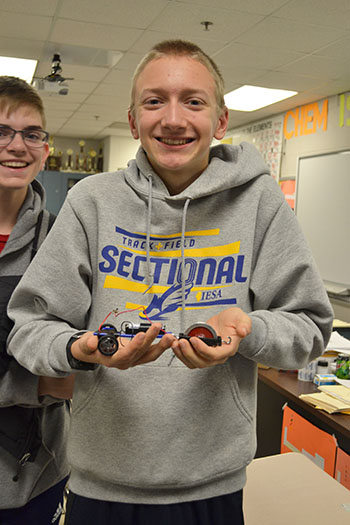
An MSHS student exhibits the car he and his teammates are building.
What’s something that teenagers might find so exciting that they’d roust themselves out of bed early on a Monday morning in order to show up at school by 7:15 AM? STEM! To be specific, the Mahomet-Seymour High School (MSHS) STEM Club, which has met every Monday morning since it was begun in late August, exposing between 15–25 young people to STEM hands-on activities and potential STEM careers each week.
The club came about as a result of CISTEME365 (Catalyzing Inclusive STEM Experiences All Year Round). The University of Illinois outreach program, funded by a National Science Foundation grant, is encouraging K–12 educators to begin STEM clubs in their schools and providing them with the expertise, training, and some of the resources with which to do it. Three folks who are invested in MSHS students and were enthusiastic about beginning a STEM club at the school participated in CISTEME365’s Institute this past summer: chemistry teacher Terry Koker; Neal Garrison, a guidance counselor; and Andrew Walmer, an MSHS alum studying the teaching of chemistry at Illinois.
According to Koker, 29 different students, ranging from freshmen to seniors, have participated in their club at some point since its beginning, with many of them attending regularly. An invitation to participate in the club was communicated to students via the school’s intercom announcement, during registration for school, and also via word of mouth, including the club’s sponsors approaching kids individually, inviting them to participate.
One of the club’s objectives, based on the plans the three sponsors made this past summer, was to equally represent both genders; they hoped to achieve a 50%-50% ratio. So how’s it going? Of the 29 participants they’ve had thus far, nine of them have been girls…around 31%. “We'd like to get that up to 50%-50%,” Koker admits. “We're trying to specifically recruit girls,” then adds, “But the ones we have are very committed and involved. We have seven or eight girls that are really into it.”
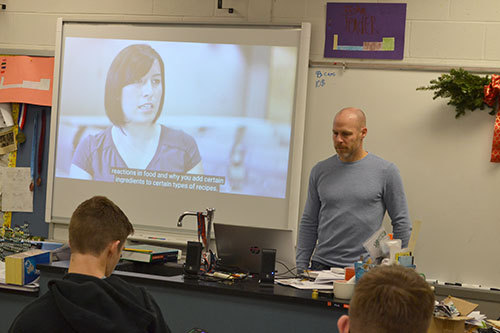
Neal Garrison shows a YouTube video clip about a STEM career.
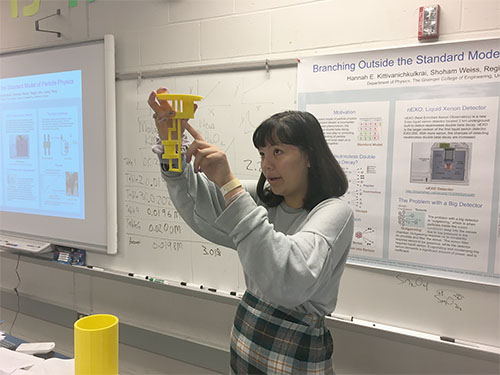
A STEM club member, Hannah Kittivanichkulkrai, gives a presentation about her summer research project. (Image courtesy of Neal Garrison.)
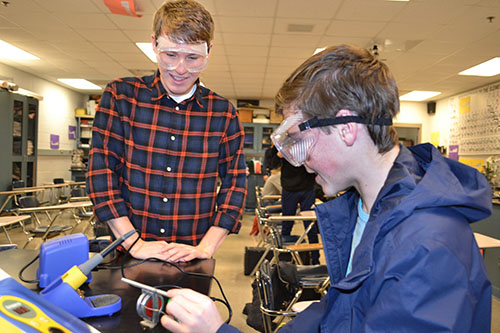
MSHS alum and club sponsor Andrew Walmer (left) helps a student with the car he's building.
Regarding the activities, the club has two main foci during the around 45 minutes they have with the young people each meeting: they introduce them to the myriad STEM careers available to them, and they try to pique their interest in STEM via a variety of engaging, hands-on activities.
Since career development is in his purview, guidance counselor Neal Garrison has been seeking to expose the participants to some of the many careers available in STEM fields. So from around 7:15–7:25 AM, while the kids are arriving, he starts out with a couple of short little YouTube videos on STEM careers. He’s mostly used 2–4-minute video clips to “keep their attention span,” making sure to include diversity and those often underrepresented in STEM, including females. “So those have been great,” Garrison says, “So it's not just, ‘I'm seeing the same culture,’ and then it's a short enough attention span that they can get a quick lesson in.” He tries to show two to three of those a week, “to kind of broaden their horizons,” he adds.
Garrison, who has been trying to get speakers to present, admits that the early hour has been a bit detrimental: “That's been harder than I thought, partially because it's a horrible time for anybody who's working.” They did have one girl from the club present: Hannah Kittivanichkulkrai, who had participated in the Grainger Engineering Young Scholars program at the University of Illinois, gave a presentation about her summer research project on neutrinoless double beta decay. “She's brave soul. She did a great job,” Garrison explains. "She had a great presentation.”
In fact, they are encouraging students to present on STEM topics they like. Garrison says there's interest, but none of the students have done it yet.
"I think the idea of presenting in front of their peers is appealing to them," he says, "but finding the time to create an organized speech or presentation on a topic is what is slowing them down. We are going to try to give them more encouragement and guidance next semester to make sure it starts to happen."
They also want students to take on roles like recruiting or writing to potential sponsors or organizing supplies after each meeting. However, while students seem interested in doing it, they haven't been active in following through.
Andrew Walmer echoes Garrison's statement that the three sponsors hope to get students more involved in a leadership role in the club."We have had good response from students so far. This next semester, we are looking to increase the amount of student-led activities in the club, since that was one of the primary objectives at the start. By giving students a larger stake in the club, I believe the students will feel more invested. Feeling more invested will then help them to get more out of the experience."
Walmer adds that in addition to getting students to take ownership of the club, several of his other goals for the club are as follows:
"To give students a comprehensive understanding of what a future in STEM will probably look like, to help students get involved in STEM programs beyond high school, and to help students develop skills they can utilize in future STEM activities and careers."
In addition to getting students more involved in giving presentations about STEM to the group, Garrison also hopes to convince students’ parents, some of whom are in STEM careers, to present. He feels parents, with a vested interest in their children succeeding in STEM, are more likely to participate despite the less-than-desirable hour.
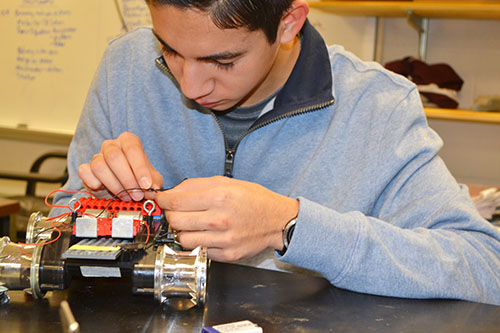
A member of the MSHS STEM club adds "headlights" to a car.
Regarding the hands-on portion of the meeting, they’ve done many of CISTEME365 PI Lynford Goddard's activities that the three sponsors themselves did this past summer. “They really seem to enjoy the circuit projects,” Koker admits.
For example, students have learned how resistors work, how LEDs work, and how to solder. They’ve done the experimental parameters activity, which involved giving kids paper bags with slightly different materials in each, then instructing students to build something with them. He says they’ve worked their way up to fairly complex circuits using the little white breadboards. While they haven’t built any transistor radios or some of the really big projects, they’ve done some with multiple LEDs, capacitors, and transistors. They also did the algorithms activity the sponsors did in the summer, which involved sorting Oracle cards, then talking about computer sorting in relation to that. Another project they did was to put together a little cardboard and glass lens microscope kit.
For December, with its finals and then Christmas break, students were assigned a make-your-own-design project. They received an electric motor, a switch, and some wire, plus they had access to boxes of Connects, Legos, balsa wood, and other materials—“just little bits and pieces of a lot of stuff I've picked up over the years,” Koker adds. The idea was that they just build something. It could be a car or something else, but it had to use a motor, batteries, and have a switch. His instructions were, “See if you can get something that’s useful and works,” then just kind of left it open ended.
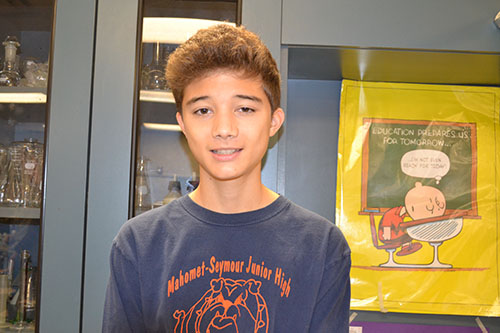 MSHS sophomore Taylor Fan.
MSHS sophomore Taylor Fan.
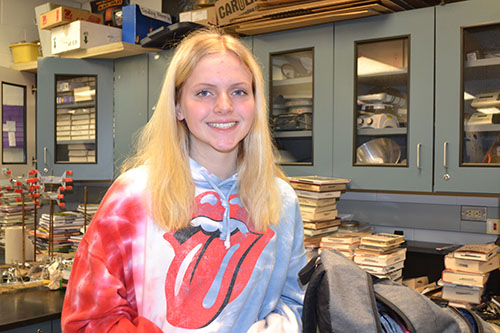
MSHS junior Casey Rittenhouse.
MSHS high school students have appreciated both aspects of the club: both the STEM career exposure and the hands-on activities. For example, one STEM club member, sophomore Taylor Fan, says the STEM club is helping him to figure out what he wants to do careerwise.
“The videos that we watch in the morning are really, really helpful, because you can see a lot of different jobs that you wanna do. They're not all the same. There's a lot of different aspects and areas to engineering, like computer engineering, civil engineering. There's a lot that you can learn from those.” In fact, Fan probably appreciates those so much because they line up with what he wants to do career wise. “I just want to go into the engineering field. I think that sounds interesting.”
He also appreciates the hands-on activities. “I think that doing these hands-on activities also is really beneficial because you're actually doing something yourself. You're leading a project, you know what I mean?” Fan says one of his favorite activities was the soldering activity. “I thought that was really interesting. And the activity that we're doing now with building whatever we want. I think we're going to start building the car, and we have to use some sort of switch element in what we're doing so that we can manually turn it on and off.”
Another member of the club, Casey Rittenhouse, a junior at MSHS, says her favorite activity so far was making the miniature microscope: “So that was pretty cool,” she acknowledges. “And I like what we're doing now, making the motors and stuff.”
Rittenhouse shares why she’s been coming to the STEM club: “Because I really like science, and I think it's interesting to find out how things work,” she explains. “And I think more girls also need to be involved in STEM.”
Rittenhouse, who hopes to be a marine biologist some day, hopes to go to school some place near the ocean. “Well, I'd like to go to the University of Florida or Florida State,” she says.
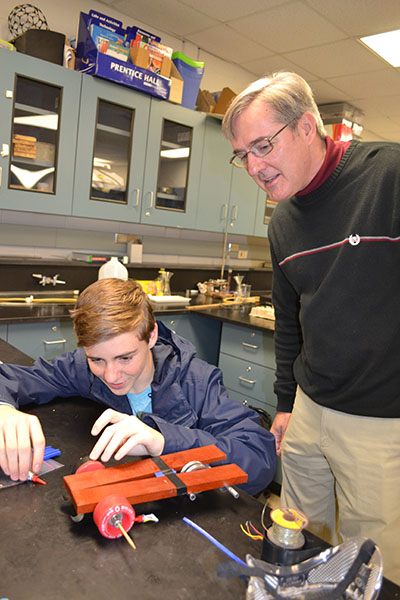
Terry Koker (right), watches a student build a car out of some balsa wood strips.
Koker finds the club to be “very rewarding," adding, "I like the fact it's non-competitive.” (Koker also sponsors competitive academic teams, and appreciates the non-competitive aspect of this club.)
Regarding what impact he believes the club is having so far on the kids, he reports, “I think it's doing what Dr. Goddard designed it to do. It's getting kids exposure to STEM, and excited about STEM—especially the exposure to new ideas about STEM. I think that's important, that they're not just thinking about it in the stereotypical way of, ‘What does an engineer do?’ They're learning the broad sense of STEM can be a lot of different things that you maybe never thought about, so maybe expanding their horizons as it pertains to STEM.”
Walmer shares the impact he believes the club is having: "I think the STEM club has already given students a better idea of what STEM encompasses. Through activities and videos during the first semester, students have been able to see and take part in the kinds of things people involved with STEM do on a regular basis."
Walmer shares his reasons for wanting to get involved with the club: "As someone who initially went to the U of I to study chemical engineering, I felt like I did not have a great idea of what it really meant to be in a STEM field, much less a chemical engineer. I wanted to get involved with CISTEME365 and the MSHS STEM club because I believed this would be a great way to introduce students to what STEM fields are all about. As someone who is now training to be a STEM educator, I also thought working with the STEM club would be great practical training."
To give readers more insight into what MSHS’s STEM club has been doing, Neal Garrison and his son have put together a website where information about the activities done each week, including the pictures that are taken, are posted. It also includes links to the different YouTube STEM career videos that have been shown each week.
Regarding the overall progress of the club, Garrison is pleasantly surprised. “I guess in some ways, I wasn't a hundred percent sure how it’d play out. I'm actually pleased that it's working out better than I thought.” He says they have 20 or so participants a week, sometimes 25. “I feel like that's quicker than I thought we would be. I thought it would take a while to kind of get going.”
Adds Koker regarding their progress: “We got off to a good start.”
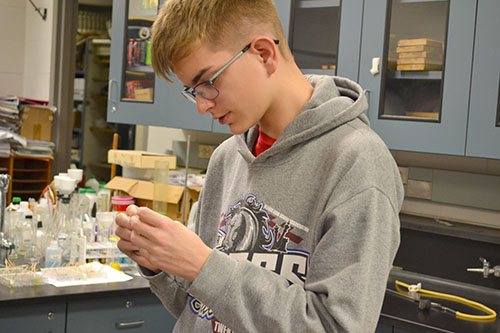
An MSHS student works on a hands-on project during the school's STEM Club.
Author/Photographer: Elizabeth Innes, Communications Specialist, I-STEM Education Initiative
More: CISTEME365, Electrical and Computer Engineering, Teacher Professional Development, 2019, K-12 Outreach
For additional istem articles on CISTEME365, please see:

MSHS sophomore Taylor Fan (left), works on December's Make-Your-Own -Design project.

A member of the MSHS STEM club adds "headlights" to a car.
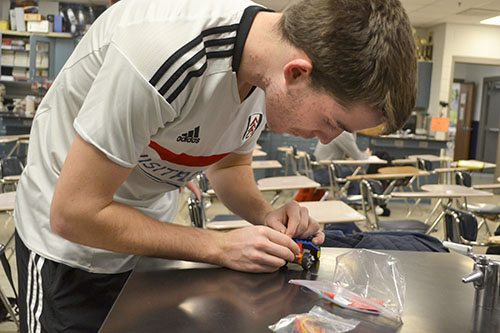
An MSHS student works on a hands-on activity.
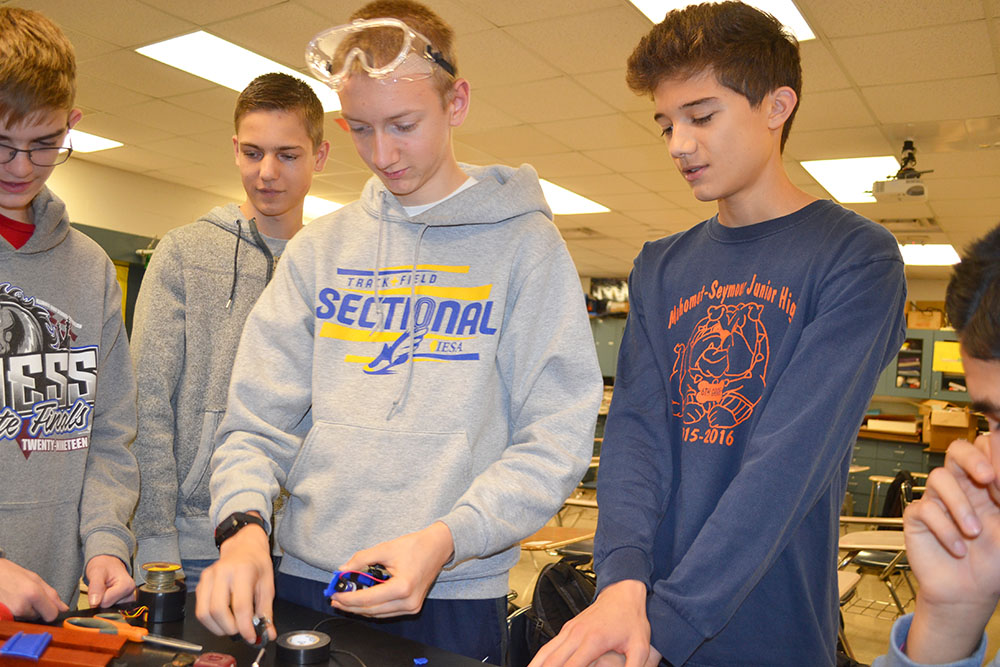
Mahomet-Seymour High School students exploring STEM through hands-on activities.













.jpg)
















